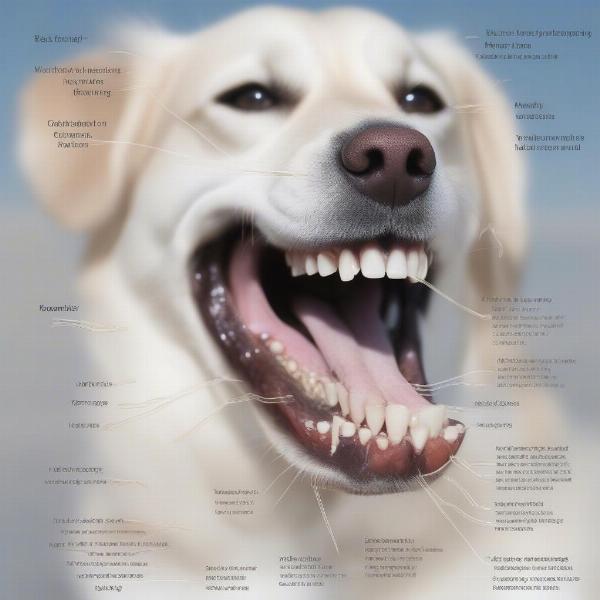Canine removal in dogs, often referring to tooth extraction, is a common veterinary procedure. Whether due to disease, trauma, or overcrowding, understanding the reasons behind canine removal, the procedure itself, and post-operative care is crucial for any dog owner. This guide will delve into every aspect of canine removal in dogs, equipping you with the knowledge to navigate this potentially stressful experience.
Why Are Canine Teeth Removed in Dogs?
Several reasons can necessitate the removal of a dog’s canine teeth, those prominent, pointed teeth at the front of their mouth. Periodontal disease, a severe gum infection, is a leading cause. If left untreated, it can damage the supporting structures of the teeth, leading to loosening and eventual loss. Trauma, such as a fracture, may also require extraction if the tooth is beyond repair. In some breeds, particularly smaller ones, overcrowding can occur, leading to misalignment and the need to remove one or more canines to alleviate pressure and prevent further dental issues.
 Dog Canine Teeth Removal
Dog Canine Teeth Removal
The Canine Removal Procedure in Dogs
Canine removal is typically performed under general anesthesia. Your veterinarian will conduct a thorough examination, including dental X-rays, to assess the extent of the damage and determine the best course of action. The procedure itself involves careful extraction of the affected tooth, ensuring minimal trauma to the surrounding tissues. In some cases, stitches may be necessary to close the extraction site. Pain medication and antibiotics are usually prescribed to manage post-operative discomfort and prevent infection.
Post-Operative Care for Canine Removal
After canine removal, providing proper care is vital for your dog’s recovery. Soft food is recommended for the first few days, gradually transitioning back to regular kibble as healing progresses. Oral hygiene is crucial, and your veterinarian may recommend specific cleaning techniques or products. Regular check-ups are essential to monitor healing and address any potential complications.
What to Expect After Canine Removal
Most dogs recover quickly and adapt well to life without a canine tooth or two. While their bite force may be slightly reduced, it rarely impacts their ability to eat or play. Some dogs might experience temporary changes in behavior, such as decreased appetite or increased salivation, but these usually subside within a few days. It’s crucial to monitor your dog closely during the recovery period and contact your veterinarian if you notice any signs of infection, excessive bleeding, or persistent discomfort.
Can My Dog Still Eat Dry Food After Canine Removal?
Yes, your dog can eventually return to eating dry food. However, immediately following the extraction, a soft food diet is necessary to avoid irritating the surgical site. As the area heals, you can gradually reintroduce dry food, starting with smaller, softer kibble. Consult your veterinarian for specific recommendations regarding your dog’s diet after canine removal.
Conclusion
Canine removal in dogs, while sometimes necessary, is a manageable procedure with a good prognosis. By understanding the reasons for extraction, the procedure itself, and post-operative care, you can ensure your furry friend receives the best possible care and enjoys a comfortable recovery. Remember to consult your veterinarian for any concerns or questions regarding your dog’s dental health.
FAQ
- How long does it take for a dog to recover from canine removal? Most dogs recover within a week or two.
- Will my dog be in pain after canine removal? Pain medication is prescribed to manage post-operative discomfort.
- Can canine removal affect my dog’s behavior? Some dogs may exhibit temporary changes in behavior, such as decreased appetite.
- What kind of food should I feed my dog after canine removal? Soft food is recommended initially, followed by a gradual transition back to regular kibble.
- Is oral hygiene important after canine removal? Yes, meticulous oral hygiene is essential to prevent infection and promote healing.
- How often should I take my dog for check-ups after canine removal? Follow your veterinarian’s recommendations for post-operative check-ups.
- Will removing a canine tooth affect my dog’s ability to eat? While bite force may be slightly reduced, most dogs adapt well and can eat normally.
ILM Dog is your trusted global resource for expert dog care advice. We cover all aspects of dog ownership, from breed selection and health to training, nutrition, grooming, and more. Whether you’re a new dog owner or a seasoned expert, our goal is to provide you with reliable, practical information to help you give your furry friend the best possible care. For any questions or to learn more about our services, contact us at [email protected] or +44 20-3965-8624. ILM Dog is committed to helping you and your canine companion thrive.